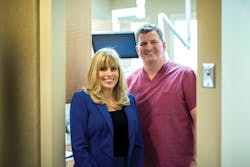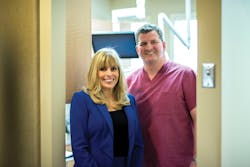Catherine's Story
Editor's note: This article is a part of Dental Economics' "Focus on Digital Dentistry," a social media feature for the month of October. Join the conversation on DE's facebook page or send us a tweet @dentalmagazine! #DEdigitalmonth
----------------
The new digital practice isn’t just an idea: it’s already changing lives
When Catherine, a retired technology coordinator from Union, N.J., began experiencing discomfort in the upper right side of her mouth, she was desperate to find someone to help her. “I had this pain that was very annoying and unresolved by many dentists,” Catherine recalls. “They looked at it, X-rayed it, imaged it, and took full mouth scans, but they couldn’t find out what the problem was.”
After several rounds of antibiotics, which relieved the pain only temporarily, Catherine believed the problem was neuralgia — a sharp pain associated with nerve damage — and was prescribed medication for this condition by a neurologist. Unfortunately, despite several attempts to increase the dose, the medicine offered no relief. Frustrated by the chronic pain and lack of answers, Catherine became extremely lethargic, depressed, and unable to function at work.
One day, while performing research on the Internet, Catherine stumbled across information about a machine that could do more than take X-rays: it could also capture three-dimensional images with the finest amount of detail. “I said to myself, ‘Maybe that’s the whole problem. Maybe these dentists just can’t see it, but I know it’s there,” says Catherine. She decided to call the company — Carestream Dental — to learn more about the 3-D imaging machine and how she could get a scan.
Catherine contacted a Carestream Dental representative and was referred to Dr. Thomas Bissell, a periodontist based out of Chester, N.J. She immediately called his practice for an appointment.
During her initial meeting with Dr. Bissell, Catherine explained her story to him. As she describes, “He just looked at me and was very, very calm about it. I said, ‘Dr. Bissell, no one else sees it. I really want to take the x-ray and see if you can see something.’’”
Using a CS 9300 system, Dr. Bissell captured a 3-D scan and came back with a diagnosis — a punctured sinus cavity caused by an implant and a separated file within the root canal-treated tooth. “My first thought was, ‘Finally, someone sees it.’ I just felt so relieved,’” Catherine remembers. “That was the beginning of my story with Dr. Bissell. He definitely made me feel like something great was going to happen.”
“We did a full evaluation for Catherine, even though her most pressing need was one particular area,” explains Dr. Bissell. “I couldn’t see it clinically, couldn’t see it with a traditional two-dimensional radiography, but we were able to find it with the CBCT scan.”
After two surgeries and a bone graft, Catherine finally found the relief that she had sought for so long. “I’m without pain now,” she states happily.
Today, the patient-doctor relationship between Catherine and Dr. Bissell is strong. “She’s a wonderful patient. She’s one of our stars,” Dr. Bissell says. “We like it when she comes to visit us. She travels quite a distance, so that’s a real compliment. We know there are other people she could see, but it really shows we’re doing something right when somebody travels a distance to come see us.”
On her end, Catherine is happy to tell others how Dr. Bissell came through for her by successfully identifying and treating her pain. “I enjoyed being with Dr. Bissell because he’s very honest, very thorough, and very good,” says Catherine.
And to think, this story was the result of an Internet search, a phone call to a dental technology company, and a dentist who could be a hero.
--------
This article is a part of Dental Economics' "Focus on Digital Dentistry," a social media feature for the month of October. Join the conversation on DE's facebook page or send us a tweet @dentalmagazine! #DEdigitalmonth

